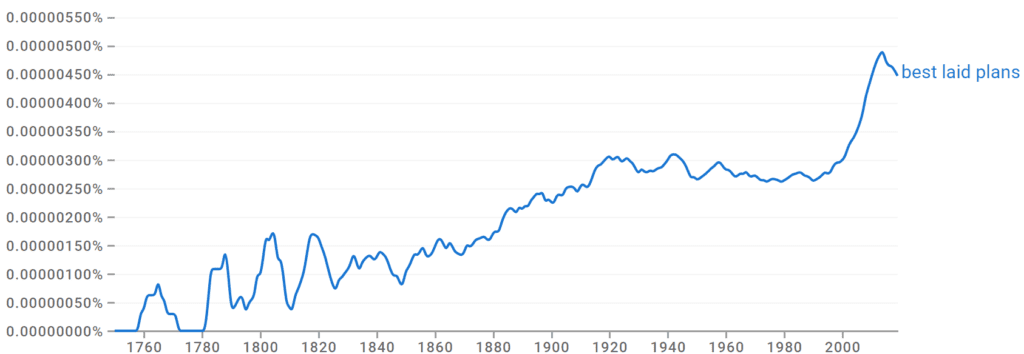Some people may argue the phrase best-laid plans is a proverb or idiom, but the saying has a weighted meaning first coined in a Scottish poem in 1786.
Its use has been influential in some of the best literature written by American authors, and as an English teacher, I have always felt the explanation of its origins is incredibly important to its proper use.
Technically a modern idiom, the phrase best-laid plans is hard to understand in a literal sense, so it remains the perfect figurative analogy. Let’s explore how the term gained its fame and why it has such a deep and heavy meaning.
What Is the Meaning of Best-Laid Plans?

“Best-laid plan” refers to something that has gone awry or something that has not turned out well as one had hoped. The expression of best-laid plans conveys that one should not expect things to always turn out as planned.
For example:
- It’s true; the best-laid plan rarely works out as expected, which is why we made sure to have a backup to avoid being stranded in another country when backpacking.
- Even the best-laid plans can change, and you shouldn’t count your chickens before they hatch.
What Is the Origin of the Quote, “The Best-Laid Plans”?
Robert (or Rabbie) Burns was widely known as the Ploughman’s Bard. A Scottish poet during the 18th century, he was also a farmer by trade and has continued to rise in popularity through the centuries, with Scots worldwide celebrating Burns Night every January 25th.
In November of 1785, Burns was plowing his fields when he turned up a mouse’s nest, which somehow deeply disturbed him and influenced him to write of this experience that evening. Whether he had been in a morose mood that afternoon or simply felt compassion towards the wee creature, his famous (and highly influential) poem was thus born.
The original line, “The best laid schemes o’ mice an’ men / Gang aft a-gley, / An’ lea’e us nought but grief an’ pain, / For promised joy,” translates as “The best laid schemes of mice and men
Go often askew,/ And leaves us nothing but grief and pain, / For promised joy!”
In the poem, Burns expresses the sorrow of his disturbance of the nest, which must have taken planning and time to build, and his quick destruction of it was symbolic of man’s disrespect of “Nature’s social union” and the inevitable disruption of even the best intentions.
Influencing American Literature
Burns became an influence on the American author John Steinbeck. Like Burns, Steinbeck was a highly educated man who felt the pull of the land, often working alongside field hands and simple fishermen – and using their stories and plights as fodder for his books.
One of his most famous books, Of Mice and Men, published in 1937, ironically started out as a children’s story called Something That Happened, but his dog ate the draft, and his plans drastically changed in the rewriting of the story.
A fan of Robert Burns, Steinbeck was touched by his poetry and felt compelled to use the line “the best laid schemes of mice and men.” The novel follows the lives of two migrant laborers trying to get ahead during the Great Depression and the consequences of the Dust Bowl. They plan and work to achieve the American Dream: a home of their own. But, as the title suggests, even the best plans can go unexpectedly astray in just a moment’s time.

Today, the term is integrated into the English language and is commonly used contextually to explain the change or disappointment in plans that didn’t go as expected.
But unless you are a literary lover, many people miss its deeply rooted analogy influenced by the utter destruction of dreams, futures, and, most recently, life.
Let’s Review
“Best-laid plans” is an arguably idiomatic phrase with a deep-rooted symbolic meaning. First used by the famous Scottish poet in his poem, To a Mouse, he describes the regret he feels concerning the destruction of the mouse’s nest and compares it to the many plans that go astray in life.
The poem influenced John Steinbeck, one of the most influential American authors, to write of the plight of American people following the Great Depression and Dust Bowl. His novel, Of Mice and Men, is taken from the line: “the best laid plans of mice and men often go astray.”
Today, the term is used in context to explain that even well-planned events or life goals may not work out as expected. Even though it is sometimes used in a more lighthearted manner, it has a deeply symbolic and slightly depressive symbolic meaning.
Enjoyed reading proverbs? Check out some others we covered:
